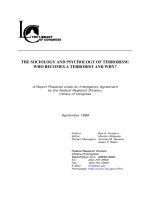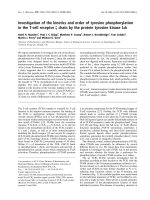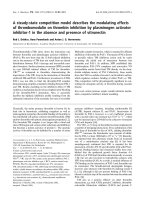The throws and takedowns of wrestling by geoff thompson
Bạn đang xem bản rút gọn của tài liệu. Xem và tải ngay bản đầy đủ của tài liệu tại đây (1.3 MB, 96 trang )
The Throws and Take-downs of
Freestyle
Wrestling
Geoff Thompson
SUMMERSDALE
Copyright © Geoff Thompson 2001
All rights reserved. The right of Geoff Thompson to be
identified as the author of this work has been asserted in
accordance with the Copyright, Designs and Patents Act of
1988.
No part of this book may be reproduced by any means, nor
translated into a machine language, without the written
permission of the publisher.
Summersdale Publishers Ltd
46 West Street
Chichester
West Sussex
PO19 1RP
United Kingdom
www.summersdale.com
Printed and bound in Great Britain.
ISBN 1 84024 028 8
First edit by Kerry Thompson.
Photographs by David W. Monks, member of the Master Photographers’ Association
Snappy Snaps Portrait Studio
7 Cross Cheaping
Coventry
CV1 1HF
Important note
If you have or believe you may have a medical condition the
techniques outlined in this book should not be attempted
without first consulting your doctor. Some of the techniques
in this book require a high level of fitness and suppleness and
should not be attempted by someone lacking such fitness.
The author and the publishers cannot accept any responsibility
for any proceedings or prosecutions brought or instituted
against any person or body as a result of the use or misuse of
any techniques described in this book or any loss, injury or
damage caused thereby.
About the author
Geoff Thompson has written over 20 books and is known
worldwide for his bestselling autobiography, Watch My Back,
about his nine years working as a nightclub doorman. He
currently has a quarter of a million books in print. He holds
the rank of 6th Dan black belt in Japanese karate, 1st Dan in
judo and is also qualified to senior instructor level in various
other forms of wrestling and martial arts. He has several
scripts for stage and screen in development with Destiny
Films.
He has published articles for GQ magazine, and has also been
featured in FHM, Maxim, Arena, Front and Loaded magazines,
and has appeared many times on mainstream television.
Geoff is currently a contributing editor for Men’s Fitness
magazine.
Geoff first learned freestyle wrestling at Birmingham Wrestling
Club under Jim Ault. He also trained with USA champion
Khris Wheelan and studied basic catch wrestling under Dave
Turton.
Thanks to Jim Ault and all the members of the Birmingham Wrestling Club.
For a free colour brochure of Geoff Thompson’s
books and videos please ring the
24-hour hotline on 02476 431100 or write to:
Geoff Thompson Ltd
PO Box 307
Coventry
CV3 2YP
www.geoffthompson.com
www.summersdale.com
Red Mist
a novel by
Geoff Thompson
‘I was dangerous because I had nothing to lose.’
Martin is a man disillusioned with life, and with good reason.
Coming from a broken home where violence was the norm,
he lives alone in a stinking flat, working as a brickie when he
can. The monotony of his existence is dramatically altered
when he meets Ginger, who is desperately trying to escape
from Mick, her obsessive boyfriend and brutal tormentor.
Keeping Ginger out of harm’s way means putting his life on
the line as Martin becomes sucked into an underworld of drugs
and violence, where arguments are settled with a fist or a
bullet.
Gripping, honest, brutal and raw, Geoff Thompson pulls no
punches in this explosive first novel that will have you on the
edge of your seat from start to finish.
Contents
Introduction
10
Chapter One: Balance, Stance, Grip
19
Chapter Two: The Cross Buttock
41
Chapter Three: The Flying Mare
53
Chapter Four: Standing Arm Roll
62
Chapter Five: Double Leg Pick-up
65
Chapter Six: Single Leg Take-down
71
Chapter Seven: The Fireman’s Carry
79
Conclusion
85
Freestyle Wrestling
Introduction
Welcome to the throws and take-downs of freestyle
wrestling, thank you for taking the time to read this book.
You are probably well aware of the fact that grappling and
ground fighting are the current favourites in the world of
martial arts, and much has been said of late about the grappling
arts. They seem to be experiencing something of a revival, a
well-earned and long awaited renaissance. Between 1899 and
1914, proper wrestling (rather than ‘show wrestling’) was
huge, so much so that the period was called the Golden Age
of Wrestling. People like Hackeschmidt, Pojelo, Stalislauz
Sabisko and the Great Turk actually made their fortunes in
the wrestling rings of Europe. The wrestlers of the day were
revered, much like the pop stars of today. The Golden Era
lost its sheen and all but died off just before, some say because
of, the Great War, only to be revived and reborn as show
grappling post-war. There was never a better time for
wrestling and now, at long last, people are starting to seek it
out once again. It is a great art and my hope is that this time
G E O F F
10
T H O M P S O N ’ S
T H R O W S
A N D
T A K E - D O W N S
Introduction
around it will stay for good as a vital part of our martial art
heritage.
Perhaps because grappling is not quite so aesthetically pleasing
as some of the other arts due to its unembellished demeanour,
its devastating potency has consequently been hidden from
the untrained eye; people are naturally drawn to the more
superfluously spectacular arts that are splashed across our
cinema screens. However, the world of combat, and more
specifically the world of martial art, has now evolved and
many of these so-called spectacular arts have failed to cut
the mustard, they have fallen well short of being effective in
an arena (the street) that does not suffer mistakes gladly. The
gorgeous systems, as I like to call them, are all shine and no
substance. The fundamental movements of the grappling arts,
so often ignored because of the Plain Jane factor, have come
to the fore and proved themselves worthy of the name
‘martial’.
G E O F F
T H O M P S O N ’ S
T H R O W S
A N D
T A K E - D O W N S
11
Freestyle Wrestling
The rise of the UFC (Ultimate Fight Competition) – cage
fighting, reality combat and extreme fighting – has done us all
a favour in that they have pointed out to all but the blind the
gaping holes in the martial armoury of most contemporary
arts. Now, everybody suddenly wants to join a grappling club.
This is great in theory because we need to be competent in
all ranges of combat so that any leaks can be sealed. The
problems start to arise when people abandon their old arts
in favour of the new and to the detriment of all the other
ranges. Grappling without punching and kicking is just as
limited as kicking and punching without grappling. I can
understand this to a degree, ground grappling is the flavour
right now and everyone (myself included) has been seduced
by it. Grappling is the prodigal son of the martial arts that has
returned home after so long. And because of the success of
grapplers in the UFC style tournaments everyone is desperate
to make up for lost time and fill his or her sack with the much
needed and oft neglected art of ground fighting. And so they
should. I’ve been trying to tell people this for the last ten
years.
G E O F F
12
T H O M P S O N ’ S
T H R O W S
A N D
T A K E - D O W N S
Introduction
Having worked as a nightclub doorman for nine years I always
knew that grappling was a vital part of the martial armoury.
But learning grappling to the exclusion of all other ranges is
suicide and this is where the problems begin. Whilst it is
important, even imperative, to include grappling on the
curriculum we should never neglect the punching and kicking
of our base systems. Especially punching because in a real
fight, where the chip shop is your arena, the art of punching
is your best chance (and often your only choice) for survival.
Go to the ground in this arena and even strangers will kick
you in the head when you’re down. They can’t help
themselves’ it’s human nature. Mix alcohol and blood and
stir in a bit of peer pressure and nice people turn into the
most despicable creatures. My point is this, what we are
ending up with now are martial artists who are training only
in grappling, they are abandoning their other disciplines such
as punching and kicking so as to concentrate all of their time
and energy on the art of floor fighting. This will leave them
impaired as martial artists. The fighter that has become a
great grappler (because he has watched and was inspired by
G E O F F
T H O M P S O N ’ S
T H R O W S
A N D
T A K E - D O W N S
13
Freestyle Wrestling
the reality tapes) finds himself being punched out in the bar
or kicked to pieces outside the chippy.
It’s important to grapple, imperative even, but it is also vital
that we stay in context. Grapple yes, I’d even insist upon it,
but never neglect the other ranges that make to complete
the armoury. If one range is neglected all ranges suffer because
when you need your skills to save your life you may be judged
on the strength of your weakest range. You are, as they say,
only as strong as your weakest link.
Equally, with the ground fighting phenomenon there has been
little or no notice taken of throwing techniques. Neil Adams
always told me that your groundwork was only as strong as
your tachi waza. If you are thrown or taken to the floor and
end in a bad position you might never get out of it, a good
player – hell, even a road digger – won’t let up once he has
the advantage. In the dojo you might lose the contest, you
can live with that; in the street it may be your life you lose if
your opponent punches your head into the tarmac while you
G E O F F
14
T H O M P S O N ’ S
T H R O W S
A N D
T A K E - D O W N S
Introduction
are on your back. Most people start their ground fighting
from a neutral position. Both fighters with an equal start.
Outside the chippy, when the fight goes live, there is no such
neutrality and you very much have to make the best of what
you are given, that is unless you are the one who controls
the take-down. Do you ever watch the prowess of ground
fighters and think, ‘It’s alright fighting on the floor but how
do you get there safely from standing?’ Me too, that’s why I
decided to write these books on the art of taking an opponent
off his feet with a practised throwing technique.
In this volume we are looking at the throws and take-downs
of freestyle wrestling. Having studied this system to instructor
level I can vouch for the potency and dynamism of this muchunderrated art. When I was training in Birmingham with the
freestyle wrestlers I was awed both by their fighting prowess
and their gentleness. On my first night at the club I thought,
rather arrogantly I might add, that I might do OK; I was strong,
I had a lot of real fight experience and I had dabbled in
grappling on and off for a number of years. When Jim, the
G E O F F
T H O M P S O N ’ S
T H R O W S
A N D
T A K E - D O W N S
15
Freestyle Wrestling
lovely instructor at the club, asked us to choose a partner I
went for the biggest guy in the place. I have to tell you that
he pulled me around like I was a baby. He was the European
heavyweight champion and he was ******* good. I have never
felt so humbled. At one stage he actually picked me up above
his head. He could have slammed me down and buried me
into the mat quite easily, but he didn’t, this gentle giant placed
me back on to my feet so that I could have another try. I was
awed by the gentleness of this man and the memory has stuck
with me ever since.
There are some excellent people at freestyle wrestling,
people a lot better than I am; I would advice and recommend
that you seek them out and get a bit of one-on-one training,
there really is no substitute.
As I have said in all of the books in this series, don’t make the
throws and take-downs the be all and end all. The same goes
with the ground fighting, on its own it is not much use, you
need to combine it with all the other physical and
G E O F F
16
T H O M P S O N ’ S
T H R O W S
A N D
T A K E - D O W N S
Introduction
psychological ranges otherwise your jigsaw is going to have
vital pieces missing.
A word of warning too: many opponents in a live scenario
will not allow you to throw them cleanly, they will panic-grip
you like their very lives depend upon it and drag you to the
floor with them. If you don’t know how to fight on the floor
then you are up shit creek.
Don’t rely on this book (or any other for that matter) to
teach you, it must be used in combination with a good class
or partner, there is nothing like a real opponent to perfect
the physical technique. Join a good wrestling club. I’d go as
far as to say that it cannot be learned properly by book alone.
Learn the fundamentals of the technique, then put it under
the pressure of a non-compliant partner to perfect. Once
you can use the technique on someone that doesn’t want to
be thrown, then you know you have got it off. Learn to do it
under pressure, too much compliance in training weakens
you and prevents you from developing the right muscles or
G E O F F
T H O M P S O N ’ S
T H R O W S
A N D
T A K E - D O W N S
17
Freestyle Wrestling
the right technique to make it happen for real. Compliance is
only of use when first learning the fundamentals of a
technique, once learned, an opponent should offer 100 per
cent resistance and he should also try to throw you. There is
nothing like the feel of taking a throw when you know that
you opponent has done everything in his power to stop you.
It builds your confidence no end. You need to fight, you need
the free sparring, taking the randori (free-fighting or sparring)
out of a system is effectively taking the claws and teeth from
a tiger.
I wish you the very best of luck with your practise and thank
you for taking the time to read the book.
G E O F F
18
T H O M P S O N ’ S
T H R O W S
A N D
T A K E - D O W N S
Balance, Stance, Grip
Chapter One
Balance, Stance, Grip
Lets start with the base. Balance is imperative, you can know
every throw in the book but it won’t help if you haven’t got
the balance and stance right. You will have little joy throwing
an opponent and you’ll be easily thrown when your balance
is off. Balance can be developed in technique work but it will
only really come together when you get on the mat and have
a few fights. You soon learn balance when everyone in the
club is trying to flatten the world with your back. When I first
started training in Birmingham my balance was way out. As a
consequence I was on the floor more times than the cleaner’s
mop. I got tired of climbing back to my feet. But that was
good, that’s how I learned. If you are in a class where you are
not getting thrown then you are in the wrong class. It’s how
you grow; and as I said, there is no better incentive to learn
than being thrown around like a paper bag in a storm night
after night.
G E O F F
T H O M P S O N ’ S
T H R O W S
A N D
T A K E - D O W N S
19
Freestyle Wrestling
Because freestyle wrestling allows attacks above and below
the waist (in Greco they only allow attacks above the waist)
the players tend to stand very low, certainly lower than they
would if they were practising Greco or judo. Because they
are crouched so low many of the traditional throws, as seen
in judo for instance, are very hard to pull off. Subsequently
the freestyle wrestler tends to aim below the waist, specifically
at the legs, with the majority of his attacks.
While fighting for a grip, good players usually work in a low
straddle stance, only moving into the wedge position (left or
right lead 45-degree stance) when preparing to attack.
G E O F F
20
T H O M P S O N ’ S
T H R O W S
A N D
T A K E - D O W N S
Balance, Stance, Grip
G E O F F
T H O M P S O N ’ S
T H R O W S
A N D
T A K E - D O W N S
21
Freestyle Wrestling
Holding this stance can be very tiring on the thighs, but that’s
why the wrestlers are so well conditioned: it is worth the
pain. These are just the fundamentals; it’s best to practise
the right way from the very beginning; if you can get yourself
into a good club – even better. I do hope that this book will
act as an appetiser for you to really get into this fantastic art.
Of all the martial arts I have practised, I’d have to say that the
grappling arts have been the most satisfying.
In all books of this genre I work on the presumption that you
are working from a left lead stance (this can be reversed of
course). This being the case, you should stand in a small 45degree wedge stance with knees bent and relaxed.
In this position your weight is directly over a point just behind
the heel of your front foot. The knees are flexed and your
back is essentially upright and almost perpendicular to the
floor. The head is up and in direct line with the spine. The
shoulders are parallel to the floor.
G E O F F
22
T H O M P S O N ’ S
T H R O W S
A N D
T A K E - D O W N S
Balance, Stance, Grip
G E O F F
T H O M P S O N ’ S
T H R O W S
A N D
T A K E - D O W N S
23
Freestyle Wrestling
In all forms of fighting, balance is everything. The wedge stance
maximises your balance so that you can shoot in and throw
your opponent. It is also pivotal to have your balance right so
that you can react quickly when your opponent tries to shoot
in and throw you. The only time that the stance should change
is when you enter to take a throw or defend a throw. After
you attack – or are attacked – immediately revert back to
the stance. If you successfully throw the opponent you have
the option to follow him down to ground or stay on your
feet. In the sporting arena you would probably follow the
opponent to the floor and fight from there. On the street,
going to the floor would not be recommended – staying
vertical would. Your choice.
Grip around the opponent’s right triceps with your left hand
and grip the back of the opponent’s neck with your right.
G E O F F
24
T H O M P S O N ’ S
T H R O W S
A N D
T A K E - D O W N S
Balance, Stance, Grip
G E O F F
T H O M P S O N ’ S
T H R O W S
A N D
T A K E - D O W N S
25









